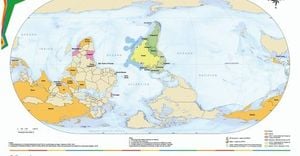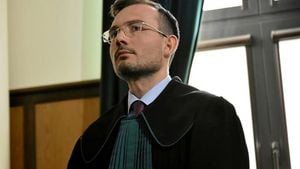On May 7, 2025, a significant moment in the history of the Catholic Church commenced as the conclave to elect a new Pope began in the iconic Sistine Chapel. This event, steeped in tradition and solemnity, follows the death of Pope Francis I, who passed away on April 21 after a remarkable 12-year tenure. The conclave will see 133 cardinals from around the globe gather in strict isolation, tasked with selecting the 267th Pope of the Catholic Church.
The day began with the last mass before the conclave, known as 'Pro eligendo pontifice,' held at 10:00 AM local time in St. Peter's Basilica. This mass, officiated by the Dean of the College of Cardinals, Giovanni Battista Re, was attended by approximately 5,000 faithful, along with numerous cardinals, bishops, and religious leaders. The atmosphere was charged with emotion as the congregation prayed for guidance in the forthcoming election.
In his homily, Cardinal Re emphasized the need for unity within the Church, highlighting the importance of selecting a Pope who can address the challenges faced by both the Church and humanity in these trying times. He stated, "We are here to invoke the aid of the Holy Spirit, to implore His light and strength, so that the pope who is elected is the one needed by the Church and humanity at this difficult moment in history."
Following the mass, the cardinals shared a final meal together before entering the conclave. This communal lunch marked the last opportunity for the cardinals to discuss their thoughts and preferences regarding potential candidates before they would be sealed in the Sistine Chapel.
At 4:15 PM local time, the cardinals gathered in the Pauline Chapel for a brief meeting before proceeding to the Sistine Chapel at 4:30 PM. Once inside, they took an oath of secrecy, pledging to maintain confidentiality about the discussions and decisions made during the conclave. This tradition underscores the gravity and sacred nature of the election process.
As the cardinals prepared to cast their votes, the first smoke signal, which will indicate the outcome of their deliberations, is expected around 7:00 PM. A white smoke plume will signify the election of a new Pope, while black smoke will indicate that no decision has been reached. The Vatican has ensured that the smoke is easily recognizable by using chemical compounds, a practice that began in 2005 to eliminate confusion among the faithful.
The conclave is particularly notable as it features the largest number of voting cardinals in Vatican history. To be elected, a candidate must secure at least 89 votes, representing a qualified majority of 80%. This heightened number of participants suggests that the process may be more prolonged and contentious than in previous conclaves, which were resolved in less than 24 hours.
Among the candidates being considered for the papacy are several prominent figures within the Church. Matteo Zuppi, the 69-year-old Archbishop of Bologna, Italy, is viewed as a strong contender. Similarly, Robert Sarah, the 79-year-old Prefect Emeritus of the Congregation for Divine Worship and the Discipline of the Sacraments, brings a wealth of experience to the table.
Other notable candidates include Luis Antonio Tagle, the 67-year-old Pro-Prefect of the Dicastery for Evangelization from Manila, Philippines; Malcolm Ranjith, the 77-year-old Metropolitan Archbishop of Colombo, Sri Lanka; and Pietro Parolin, the 70-year-old Secretary of State of the Vatican. Each candidate carries unique perspectives and experiences that could shape the future direction of the Catholic Church.
As the conclave unfolds, security measures around the Vatican have been heightened to ensure the safety of the cardinals and the public. Starting at 3:00 PM local time, mobile coverage within Vatican territory was disconnected to maintain the confidentiality of the proceedings. This decision reflects the Church's commitment to protecting the integrity of the election process.
Throughout the day, journalists and observers gathered outside the Vatican, eagerly awaiting updates on the conclave. The atmosphere in Rome was calm, with cloudy skies and a light drizzle adding to the solemnity of the occasion. The public was largely restricted from accessing St. Peter's Square, with only small groups allowed to gather and watch the mass on large screens set up for the occasion.
As the cardinals enter the Sistine Chapel, they will engage in a series of votes, with the first being a preliminary ballot to gauge support for various candidates. Historically, these early votes can provide insight into the potential direction of the conclave and the eventual outcome.
The conclave's significance extends beyond the immediate election of a new Pope; it represents a moment of reflection and renewal for the Catholic Church. The cardinals' deliberations will address pressing issues facing the Church, including its role in contemporary society, interfaith dialogue, and the need for spiritual leadership in a rapidly changing world.
As the faithful around the globe await the results, the conclave serves as a reminder of the enduring traditions of the Catholic Church and the profound impact of its leadership on millions of believers. With the eyes of the world on the Sistine Chapel, the anticipation builds for the moment when the new Pope will be revealed, marking the beginning of a new chapter in the history of the Church.



